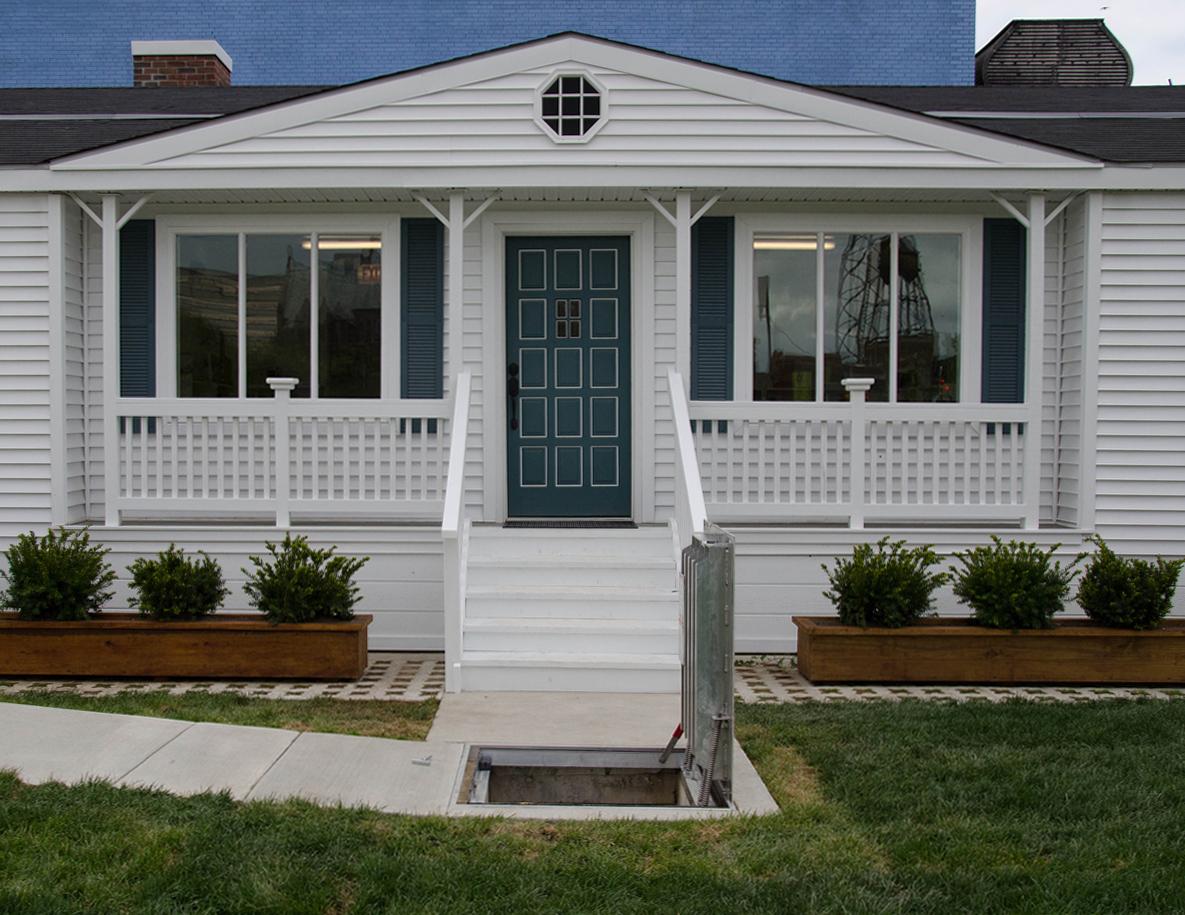Detroit’s Mobile Homestead welcoming above ground, ominous below
Mobile Homestead by Mike Kelley is on display at the Museum of Contemporary Art Detroit. (© Estate of Mike Kelley. All rights reserved. Courtesy of Mike Kelley Foundation for the Arts / Photo by Julia Lowrie Henderson.)
In downtown Detroit, among office buildings, vacant lots, and abandoned factories, sits a suburban home — a gleaming white single-story ranch with blue shutters sitting on lush mowed grass.
In this landscape, it’s like some suburban version of The Wizard of Oz.
But this house wasn’t dropped by some fantastical tornado. This is Mobile Homestead, and it’s a creation of artist Mike Kelley, who died last year. The house is a replica of his childhood home in the Detroit suburb of Westland.
Kelley had wanted to buy the actual building, but when the current owner wouldn’t sell, he did the next best thing: construct a replica at the Museum of Contemporary Art Detroit.
Mobile Homestead is intended as a public space, for events, activities, and community services to be programmed by the museum.
Kelley’s friend John Welchman, an art professor at the University of California San Diego, said “Mike wanted to produce the possibility of his own home, this place that stood for himself, in the end, being able to do some objective public good.”
But that’s the ground floor of the ranch house. What sits beneath Mobile Homestead is a completely different story. Kelley designed a basement level of bunkerlike rooms that can only be reached by a series of ladders and tunnels.
This is definitely private space — it does not meet any kind of code for safety — that Kelley intended for “rites and rituals of an aesthetic nature.”
“It makes you feel like you’re lost,” said Kelley’s friend and bandmate Cary Loren, “even though you’re maybe 20 feet into it or 30 you kind of lose your equilibrium. You just don’t feel entirely safe in there.”
What are these tunnels?
Kelley “was obsessed with this idea of subterranean space” Welchman said. He became increasingly agoraphobic. And he was intrigued with stories like that of the McMartin Preschool, where childcare workers were falsely accused of bizarre rituals and sexual abuse in tunnels below the preschool.
Kelley made a work called Educational Complex influenced by that trial. He designed models of every school he attended from memory; the spaces he couldn’t remember he left blank, and filled in those spaces with videos representing traumatic experiences that might have happened there.
Kelley explicitly denied that he himself had been victimized. But his obsession with the subject is complicated by serious depression that led to his suicide in January 2012 — immediately after he finalized arrangements for the piece.
Kelley left no note — what he left was Mobile Homestead. Welchman sees a complex psychological metaphor in the piece.
“The very fabric of Mobile Homestead, the base on which it stands, is the idea that public art may in the end be based on lies and deception, it may be based on wishful thinking at the very least,” he said.
Some part of Mike Kelley’s psyche was as dark and unsafe as the tunnels he built below his house.
Kelley’s Mobile Homestead was commissioned by Artangel in association with the Museum of Contemporary Art Detroit, LUMA Foundation and the Mike Kelley Foundation for the Arts. It opened in Detroit on May 11and will sit in permanent residence on MOCAD’s property.
The story you just read is not locked behind a paywall because listeners and readers like you generously support our nonprofit newsroom. If you’ve been thinking about making a donation, this is the best time to do it. Your support will get our fundraiser off to a solid start and help keep our newsroom on strong footing. If you believe in our work, will you give today? We need your help now more than ever!
